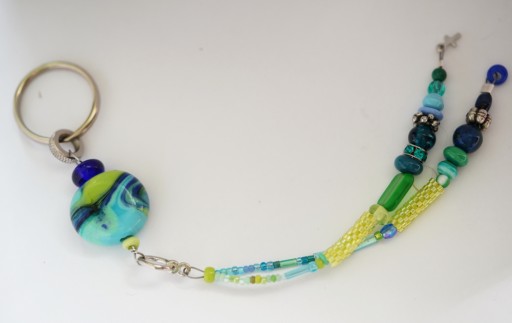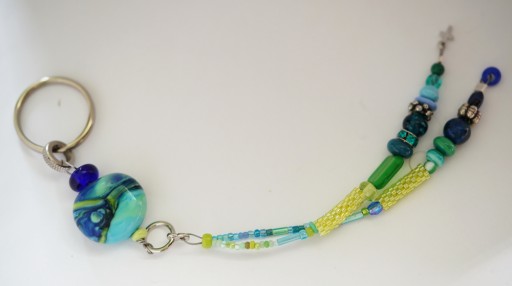This is the second in a series of 4 dead mice featuring peyote stitched tubes made by someone else that I purchased in a thrift store, and arguably the one in which those same pieces are most clearly the secondary focal of the piece; the peyote woven tubes blend in more in all the others.

lampwork bead, probably czech glass; found peyote stitched tubes of delicas; other seed, czech, lampwork & basemetal beads, probably strung on beadalon; photographed 15jun2021, sony ILCE-7C, sony 90mm macro, f/2.8, ev +1.0, 1/100s, ISO 1000; cropped, lightened; scaled to 4000 pixels in gimp (click for the sharp full size version)
The flattened oval bead, probably made from a mishmash of opaque, cool coloured czech glass, has differing front and back sides, so I photographed both. Though I'd say the pattern in the second photo is more interesting, the larger lime component in the first points up why I chose this bead: to match the lime delica tubes.
I didn't clean up the bottom triangle on the right this time;)

reverse of above: lampwork bead, probably czech glass; found peyote stitched tubes of delicas; other seed, czech, lampwork & basemetal beads, probably strung on beadalon; photographed 15jun2021, sony ILCE-7C, sony 90mm macro, f/2.8, ev +1.0, 1/100s, ISO 1000; cropped, lightened; scaled to 4000 pixels in gimp (click for the sharp full size version)
Though one of the beads looks a bit like malachite, and given the less than stellar lighting, especially on the right side of the image, it's hard to tell whether the dark blue beads are sodalite (or even low grade lapis) all of them are, in fact, glass: one of the interesting qualities some opaque glasses (such as the ones used to make the focal) in general and of petroleum green in particular is viscosity effects, which in mandrel wound hollow beads made of petroleum green look quite like malachite, both in terms of colour and banding.
Unless otherwise noted, text, image and objects depicted therein copyright 1996--present sylvus tarn.
Sylvus Tarn